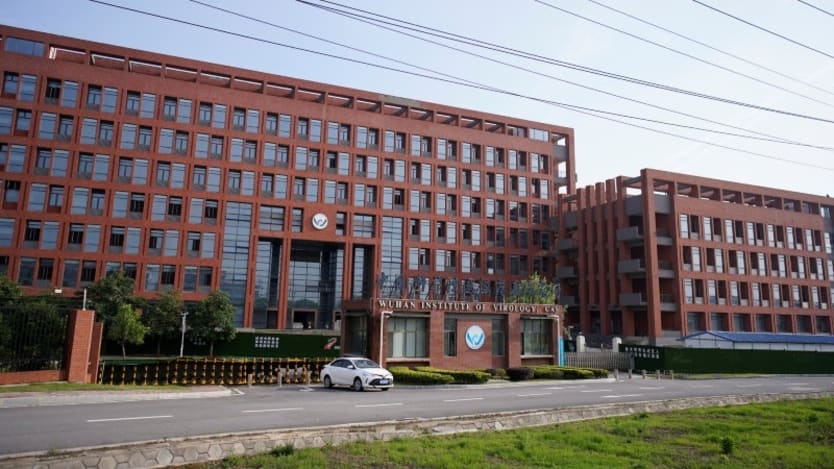
Several hypotheses remain on the table regarding the origins of the virus that causes COVID-19, but the World Health Organization on Tuesday ruled it “extremely unlikely” that SARS-CoV-2 leaked from a laboratory, as an international mission of experts investigates in Wuhan, China.
“The findings suggest that the laboratory incident hypothesis is extremely unlikely to explain the introduction of the virus into the human population,” said Peter Ben Embarek, a food safety scientist with WHO and the international mission lead, during a joint press briefing Tuesday with Chinese officials.
Among the evidence against such a possibility is that no lab in the world has SARS-CoV-2 or a closely linked virus, Embarek said. The team also visited the Wuhan Institute of Virology and found it “very unlikely that anything could escape from such a place.”
Embarek added, “We also know that when lab accidents happen, they're of course extremely rare.”
There has been much speculation over the past year around the origins of the virus, including suggestions of a leak from the Wuhan Institute of Virology — a theory fueled by former U.S. President Donald Trump, who repeatedly blamed the Chinese government for the COVID-19 pandemic. China had long rejected this hypothesis.
In May, the World Health Assembly asked WHO to conduct an independent inquiry into the virus’s origins and how it spilled over to humans. An initial two-person team went to China in July to develop the scope and terms of reference for a WHO-led international mission.
“Our initial findings suggest that the introduction through an intermediary host species is the most likely pathway ... and one that will require more studies.”
— Peter Ben Embarek, food safety scientist, WHOHowever, it took months of negotiation before the international mission was allowed entry into the country. An initial attempt in early January 2021 by some members of the team was canceled after slow visa approvals, over which WHO Director-General Tedros Adhanom Ghebreyesus expressed disappointment.
WHO was expecting team members to deploy in the first week of January, but the mission was only able to enter China on Jan. 14. They underwent two weeks of quarantine before visiting hospitals in Wuhan that treated early COVID-19 cases, as well as the Huanan Seafood Market that was linked to the first COVID-19 cases identified in December 2019.
In presenting the findings Tuesday, Embarek said the investigation did not dramatically change the picture that the team had of the virus’s origins and how it spilled over to humans. However, it improved their understanding of what happened. There had been a lack of evidence of large outbreaks that might have been COVID-19 prior to December 2019 in Wuhan or elsewhere. However, the team found evidence of the virus circulating outside the Huanan market, which Embarek called “a very classical picture of the start of an emerging outbreak.”
Virus origins
COVID-19 is believed to have originated in some form through animals. The investigators were unable to pinpoint an animal species that could have served as a potential reservoir of the disease, despite large amounts of testing of domestic and wild animals in many different Chinese provinces.
Much of the work that has been done to date points to bats. But since Wuhan is far from any bat populations, introduction of the virus from bats to Wuhan “is not very likely,” Embarek said.
The team looked at other animal species that could have potentially introduced or contributed to the introduction of the virus in Wuhan, and it identified vendors selling frozen animal products and farmed wild animals in the Huanan market, as well as the farms supplying these products. Many came from different parts of China or even other countries, opening new avenues “to follow these leads and further look at the supply chain,” Embarek said.
Next steps
The team members looked at all possible pathways for the virus’s introduction into humans and identified four hypotheses, Embarek said. Among them was the theory that it escaped from a lab, but they are no longer pursuing that idea, given the conclusions they’ve arrived at.
The three other hypotheses, however, are still on the table and will be the focus of further work. One is the possibility that the virus was directly transmitted from an animal species to humans. The second is that the virus was spread via an intermediary host or animal species that is closer to humans. The third is that the virus was introduced in the food chain, such as frozen food products.
“Our initial findings suggest that the introduction through an intermediary host species is the most likely pathway ... and one that will require more studies and more specific, targeted research,” Embarek said.
The mission’s report lists key recommendations for future studies, he said, such as continuing to analyze materials from the early days of the outbreak. These materials include blood samples from blood banks within China as well as in other countries where there were initial reports indicating the virus was present.
The team also wants to survey other animal species that could have served as a reservoir for the virus and conduct more sampling and studies of bat populations outside China.
Opinion: Support animal health systems to prevent the next pandemic
Infectious disease transmission from animals to humans is increasing — in frequency, virulence, and devastation. This op-ed explores three ways to prevent future pandemics and global health crises.
“We should also look further back in tracing the source … of the animal products, in particular, that were in Huanan market in December 2019 and go back and see if we can find products that were produced at that time and that are still available to also look at the suppliers to these vendors in the market, see if we can go further back in terms of identify interesting clues in the farming environments in the species being raised in these farms and where they were potentially coming from before that,” Embarek said.
Marion Koopmans, head of the Viroscience Department at Erasmus MC in the Netherlands and part of the international team, said rabbits and other species identified during tracing investigations were found to be susceptible to the virus. Still other species identified during tracing, such as ferret-badgers and bamboo rats, are suspected to be susceptible.
“So the way that is interpreted is to really say, well, if they were there then, then maybe there could have been similar animals earlier. So it is an entry point for a traceback investigation,” Koopmans said.
In developing their hypotheses, team members made sure they were not limiting themselves to a particular geographical area or “preconceived ideas” about the origins of the virus and sought to follow all leads based on science and well-designed studies, according to Embarek.
For instance, a literature review conducted by the team identified a study suggesting the virus may have been circulating in Italy in late November 2019, although it did not provide definitive evidence, Koopmans said.
“But these parts of information [are] part of what we collected, reviewed, and included in our recommendations for the next step. So in the next step, what we say is, we should really go and search for evidence for earlier circulation, wherever that is indicated, and indications like this can come from that kind of literature,” she said.

